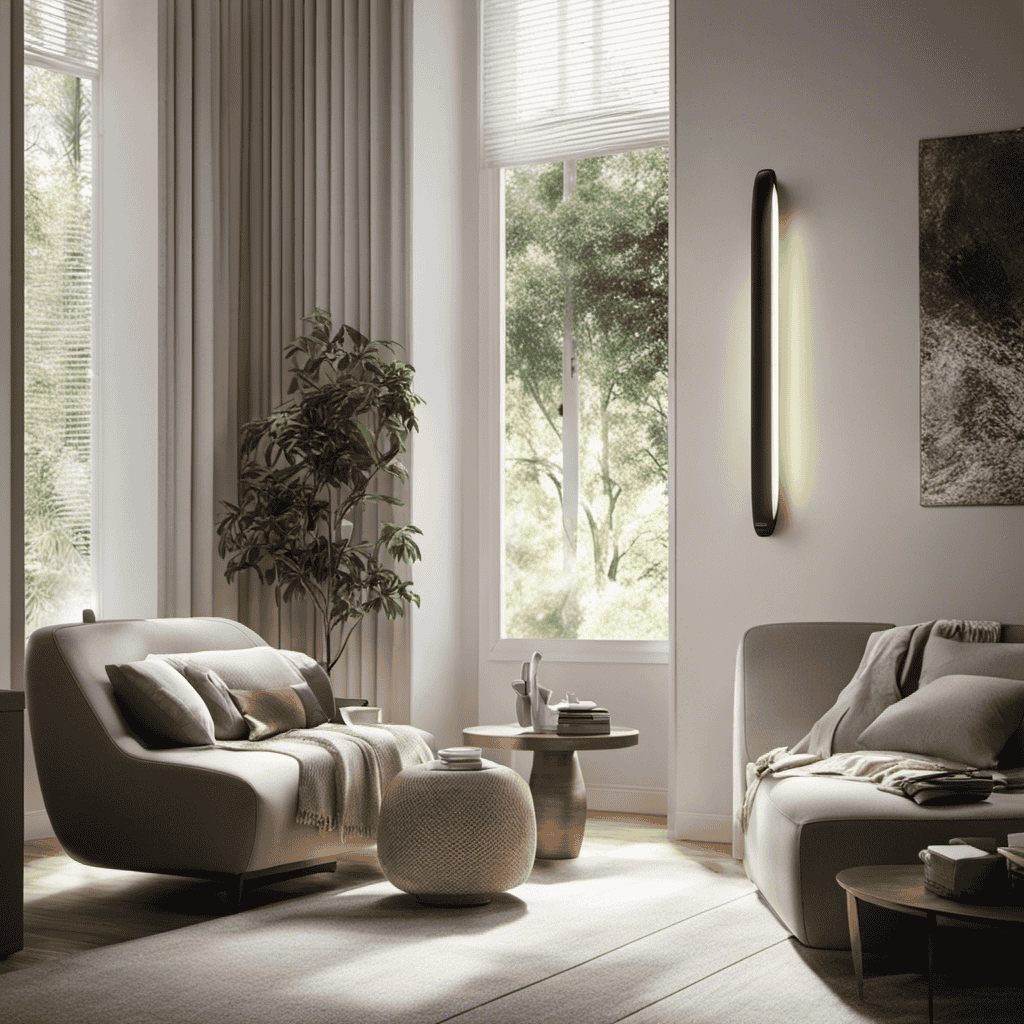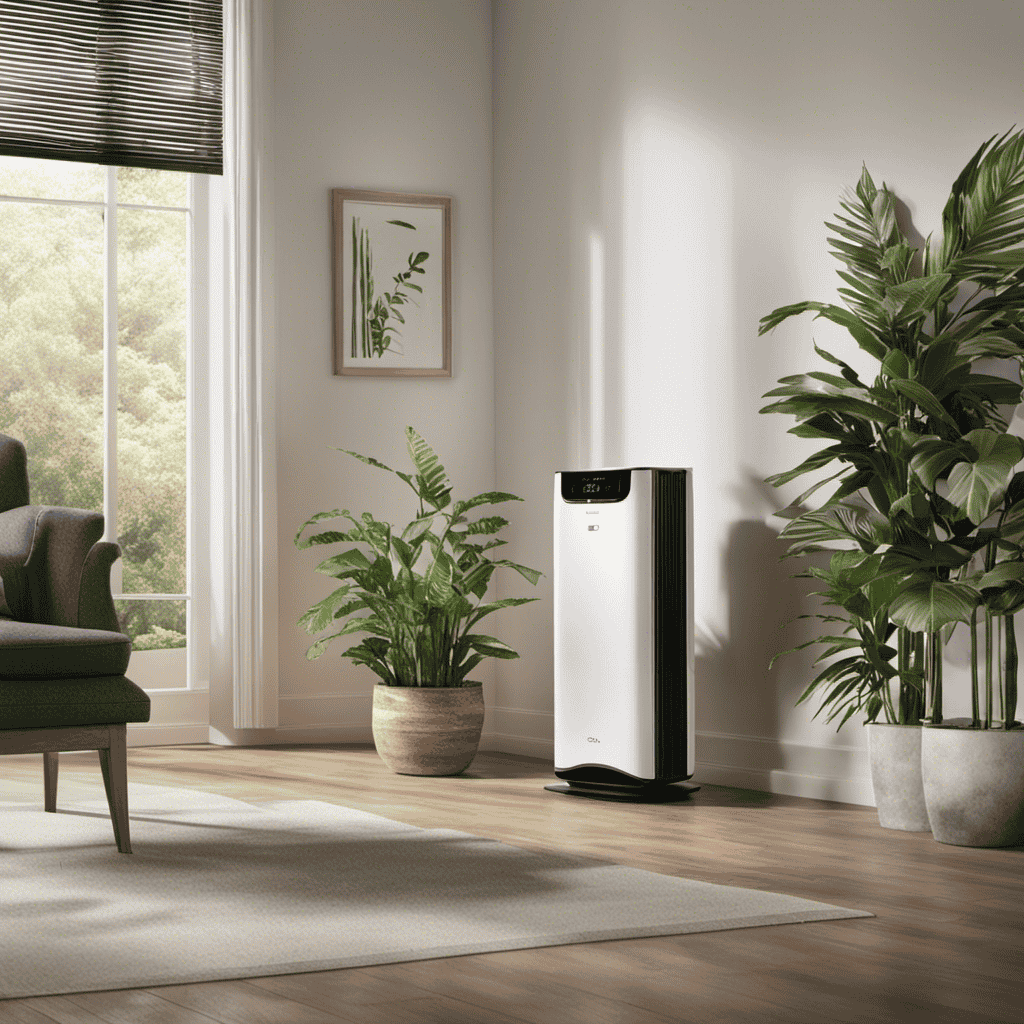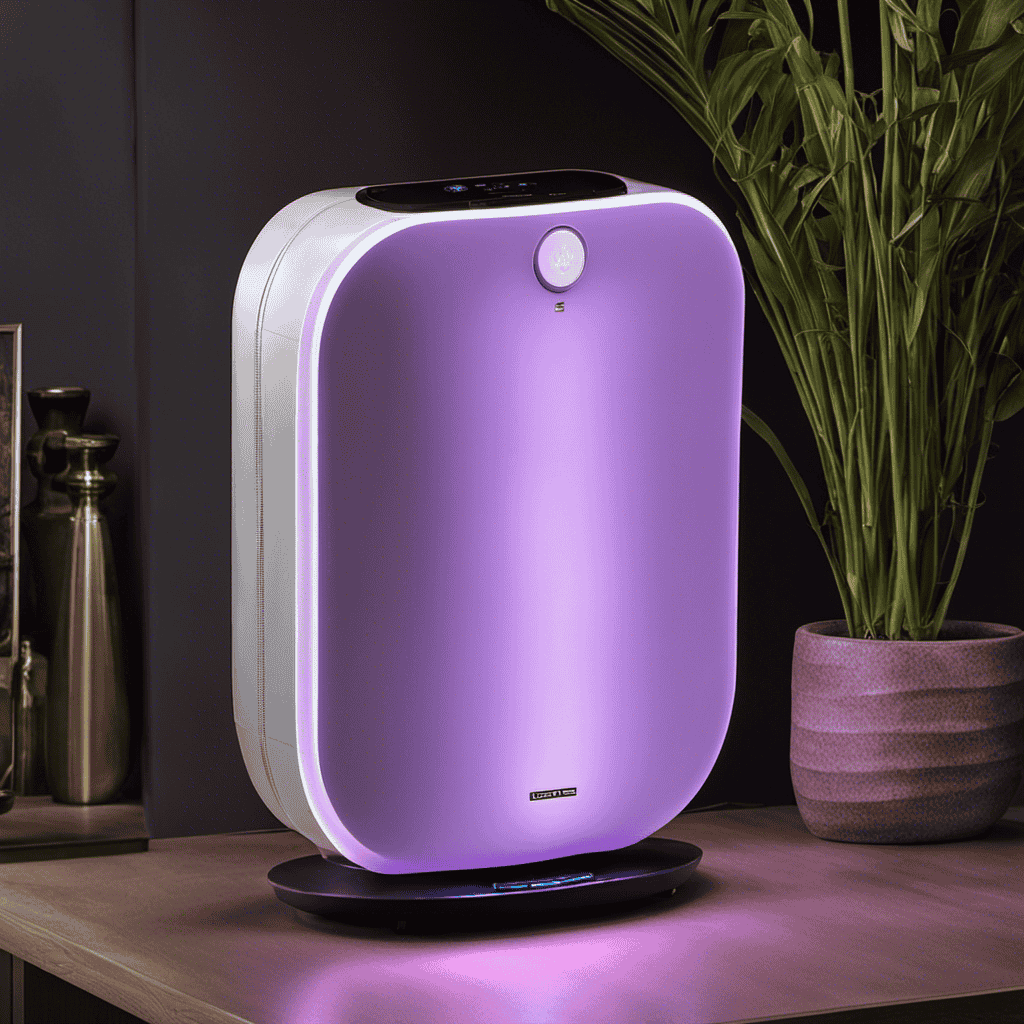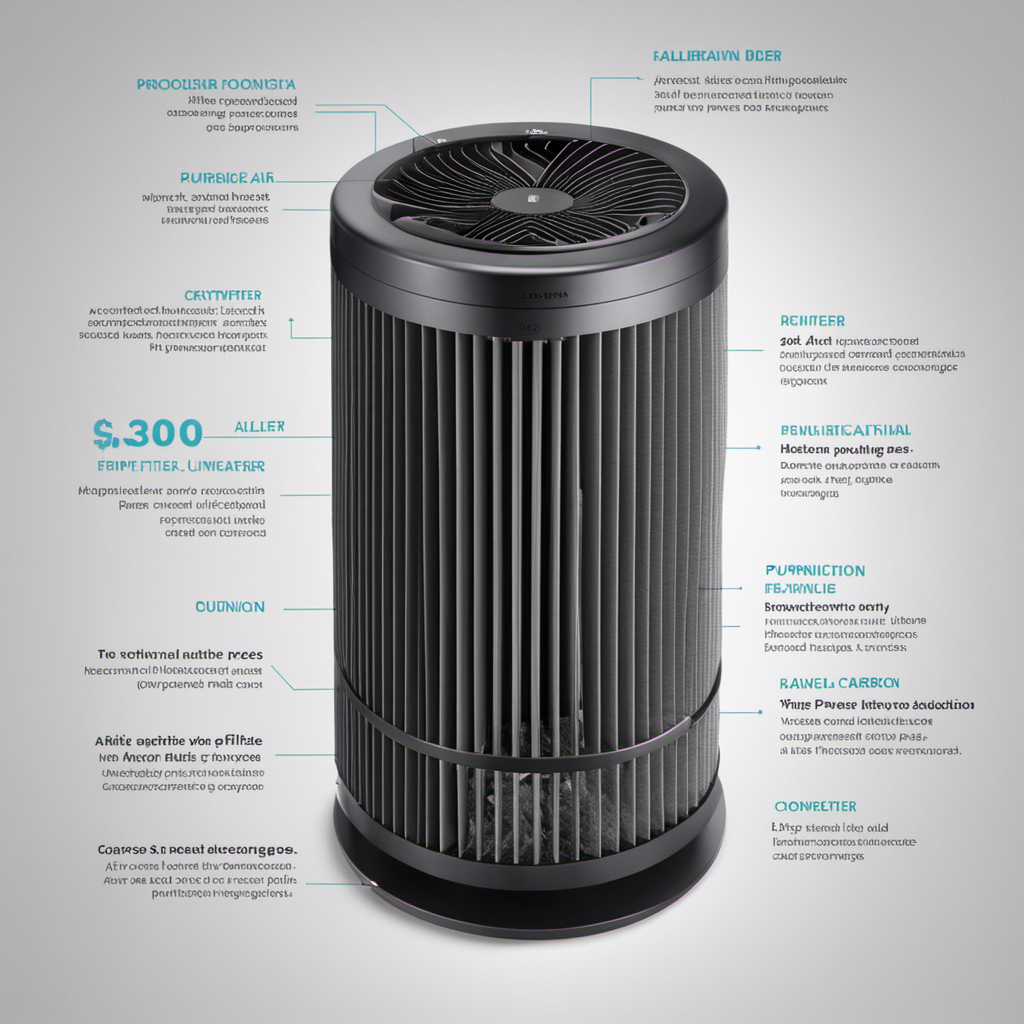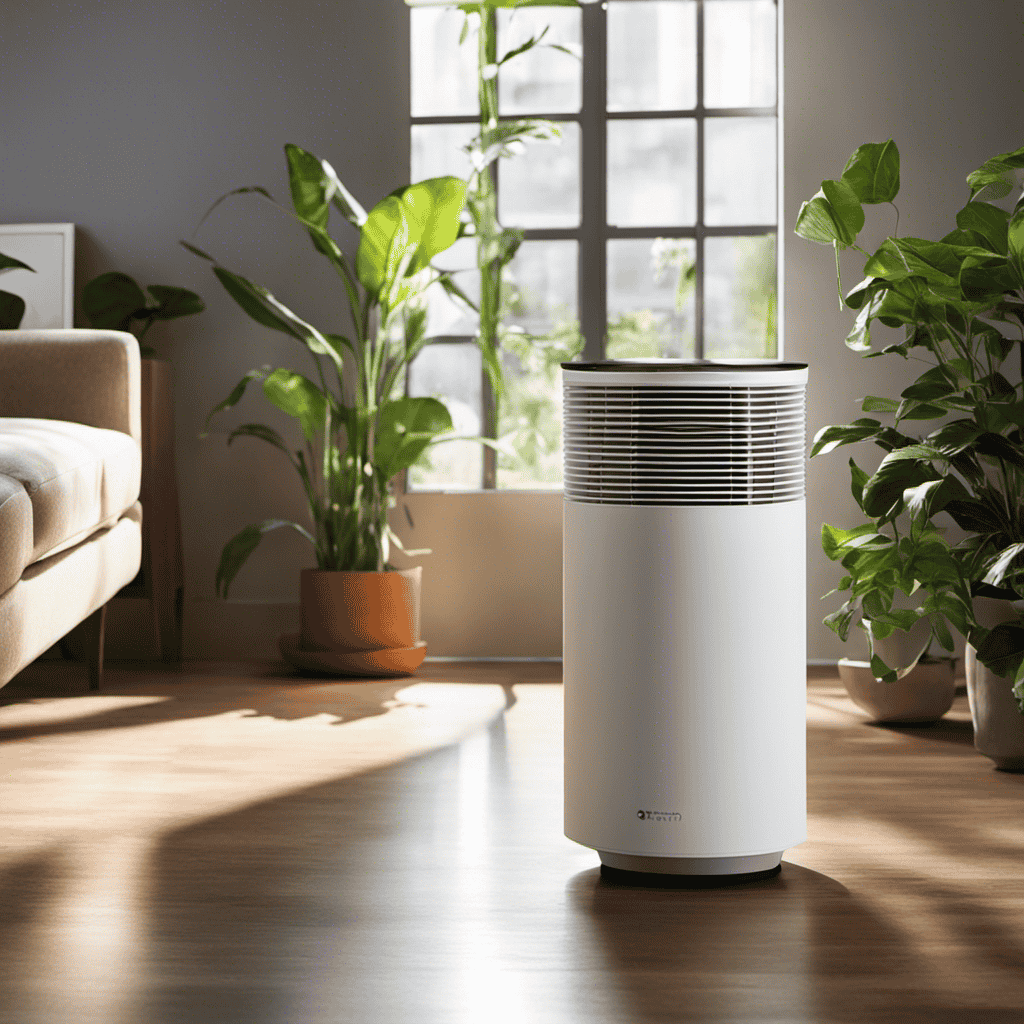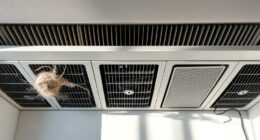As someone who owns a room air purifier, I can confidently attest to its effectiveness in ensuring clean and fresh indoor air.
But what exactly does a room air purifier do? In simple terms, it works by filtering out pollutants and allergens, leaving you with healthier air to breathe.
In this article, we will explore the inner workings of a room air purifier, the benefits it provides, and how it can improve your indoor air quality.
Let’s dive in and discover the wonders of this remarkable device.
Key Takeaways
- Room air purifiers work by removing harmful particles from the air through filtration and circulation.
- The effectiveness of a room air purifier depends on factors like room size and filter type.
- Regular maintenance, including cleaning or replacing filters, is crucial for optimal air purifier performance.
- Purifier performance indicators, such as filter replacement and air quality indicators, help ensure the purifier is improving air quality effectively.
How Does a Room Air Purifier Work
A room air purifier works by removing harmful particles from the air, such as dust, pollen, and pet dander. It does this through a combination of filtration and circulation. The air purifier draws in the surrounding air, which passes through a series of filters. These filters are designed to capture and trap particles, preventing them from recirculating back into the room.
The most common type of filter used in air purifiers is a High-Efficiency Particulate Air (HEPA) filter, which can remove particles as small as 0.3 microns with an efficiency of 99.97%. Once the air is filtered, it is released back into the room, creating a cleaner and healthier environment.
The benefits of using an air purifier in the bedroom are numerous. Firstly, it can help improve indoor air quality, reducing the presence of allergens and pollutants that can trigger respiratory issues and allergies. This can lead to better sleep and overall well-being.
Secondly, air purifiers can help eliminate unpleasant odors, such as those caused by pets, smoke, or cooking, creating a more pleasant and fresh-smelling bedroom.
Lastly, air purifiers can help reduce the accumulation of dust on surfaces, making cleaning easier and reducing the risk of dust-related allergies and asthma symptoms.
Benefits of Using a Room Air Purifier
One of the advantages of using a room air purifier is that it helps to improve indoor air quality. This is especially beneficial for individuals with allergies or respiratory conditions.
In addition to improving air quality, there are other benefits to consider when using a room air purifier:
-
Cost-effectiveness:
-
Room air purifiers are generally more affordable than whole-house air purifiers.
-
They require less maintenance and have lower operating costs compared to other air purification systems.
-
Noise levels:
-
Room air purifiers are designed to operate quietly, ensuring minimal disruption to your daily activities.
-
Many models come with adjustable fan speeds, allowing you to customize the noise level according to your preference.
Common Types of Room Air Purifiers
When considering room air purifiers, it is important to evaluate their filter effectiveness ratings, features and functions, as well as their suitability for different room sizes.
Filter effectiveness ratings indicate the purifier’s ability to remove pollutants and allergens from the air, with higher ratings representing better filtration.
Features and functions vary among different models, ranging from basic options like fan speed control to more advanced features like air quality sensors and automatic mode.
Lastly, room size suitability is crucial as purifiers need to be able to effectively clean the air in the given space, so understanding the square footage recommendations for each model is essential.
Filter Effectiveness Ratings
Room air purifiers with higher filter effectiveness ratings can remove a greater amount of pollutants from the air. These high efficiency filters are designed to capture even the smallest particles, such as pollen, dust, pet dander, and mold spores. This ensures that the air in your room is cleaner and healthier to breathe.
When choosing an air purifier, it’s important to consider the noise levels as well. Some models may produce loud noises, which can be disruptive, especially during nighttime or when you need a quiet environment. Look for air purifiers that offer low noise levels, so you can enjoy the benefits of clean air without any disturbance.
Features and Functions
To get the most out of your air purifier, make sure to choose a model with a variety of useful features and functions.
When considering features, it’s important to keep in mind the price range and energy consumption of the room air purifier. Price range can vary greatly depending on the brand, size, and additional features included. It’s important to find a balance between cost and functionality.
Additionally, energy consumption is a crucial factor to consider. Look for models that are energy-efficient and have adjustable settings to optimize performance while minimizing power usage.
Some air purifiers also come with features like multiple fan speeds, air quality sensors, and programmable timers, which can enhance convenience and customization.
Room Size Suitability
Finding an air purifier that’s suitable for your room size is essential for effective and efficient air filtration. When considering the room size suitability of an air purifier, there are two important factors to keep in mind:
-
Coverage Area: Determine the square footage of your room to ensure the purifier can effectively clean the air within that space. Different models have different coverage capacities, so it’s crucial to choose one that matches your room size.
-
CADR Rating: Look for an air purifier with a high Clean Air Delivery Rate (CADR) rating. This rating indicates how quickly the purifier can filter the air in a specific room size. A higher CADR rating means better room air purifier effectiveness.
Additionally, noise levels are an important consideration when choosing a room air purifier. Look for models that have low noise levels, especially if you plan to use the purifier in a bedroom or office.
By selecting an air purifier that is suitable for your room size and operates at low noise levels, you can ensure optimal air filtration without any disturbances.
Now, let’s explore the key features to look for in a room air purifier.
Key Features to Look for in a Room Air Purifier
When considering a room air purifier, you should look for key features like HEPA filters and adjustable fan speeds. HEPA filters are essential for trapping microscopic particles, such as allergens, dust, and pet dander, ensuring cleaner and healthier air in your room.
The adjustable fan speeds allow you to customize the purifier’s performance based on your specific needs.
Additionally, it is important to consider the reputation of air purifier brands and the cost of air purifiers. Trusted brands often offer superior quality and durability, while the cost of air purifiers can vary depending on the features and technology they offer.
It is crucial to find a balance between your budget and the effectiveness of the air purifier in improving your indoor air quality.
Do Room Air Purifiers Remove Odors
Moving on from the previous subtopic about key features to look for in a room air purifier, let’s now explore whether these devices can effectively remove odors.
When it comes to eliminating unpleasant smells, room air purifiers are a far better option than scented candles. Here’s why:
-
Room air purifiers:
-
Utilize HEPA filters to capture and trap microscopic particles, including odor-causing molecules.
-
Help improve indoor air quality by removing pet dander, dust, pollen, and other allergens that can contribute to odors.
-
Scented candles:
-
Mask odors temporarily by releasing fragrances into the air.
-
Do not address the root cause of the odor, and the scent may fade quickly, leaving the original smell behind.
Can a Room Air Purifier Help With Allergies
If you suffer from allergies, using a room air purifier can provide relief by reducing the amount of allergens in the air. Room air purifiers are designed to effectively capture and remove common allergens such as dust mites, pollen, pet dander, and mold spores.
These devices work by pulling in air from the room and passing it through a series of filters that trap and remove these particles. The effectiveness of a room air purifier in alleviating allergy symptoms depends on factors such as the size of the room and the type of filters used.
However, the benefits of using a room air purifier for allergies can include improved indoor air quality, reduced allergic reactions, and a cleaner and healthier living environment.
Transitioning to the next section, it is important to consider what size room air purifier you need to effectively purify the air in your specific space.
What Size Room Air Purifier Do I Need
When considering which room air purifier to purchase, it’s crucial to understand the room size requirements. A larger room will require a more powerful purifier to effectively clean the air.
Additionally, air quality considerations such as the presence of allergens, pollutants, and odors should be taken into account.
Lastly, purifier performance indicators like the Clean Air Delivery Rate (CADR) and the Air Changes per Hour (ACH) can help determine the effectiveness of the purifier in improving indoor air quality.
Room Size Requirements
To determine the room size requirements for an air purifier, you’ll need to consider the square footage of the space you want to purify. This is an essential step in ensuring that the air purifier can effectively clean the air in your room.
Here are some key points to consider when determining your room size requirements for a room air purifier:
-
Measure the square footage of your room: Use a measuring tape to determine the length and width of your room. Multiply these measurements to get the square footage.
-
Consider the CADR rating: The Clean Air Delivery Rate (CADR) is a measure of an air purifier’s efficiency in removing pollutants. Choose an air purifier with a CADR rating that matches the square footage of your room.
-
Factor in the air changes per hour (ACH): The ACH indicates how many times the air in a room is completely filtered per hour. For optimal purification, choose an air purifier that can provide at least 4-6 air changes per hour for your room size.
By considering these factors, you can ensure that your room air purifier effectively cleans the air in your space, providing you with the many benefits of improved indoor air quality.
This guide will help you make an informed decision when purchasing a room air purifier.
Air Quality Considerations
In order to maintain the optimal performance of your air purifier, regular maintenance is crucial. By properly caring for your air purifier, you can ensure that it continues to effectively remove harmful pollutants from the air in your room.
One of the most important aspects of air purifier maintenance is regularly cleaning or replacing the filters. Over time, the filters can become clogged with dust, allergens, and other particles, reducing the purifier’s efficiency. By following the manufacturer’s guidelines, you can ensure that your filters are clean and functioning properly.
Additionally, it’s important to regularly clean the exterior of the air purifier to remove any dust or debris that may accumulate. This can be done using a soft, damp cloth.
By properly maintaining your air purifier, you can prolong its lifespan and ensure that it continues to provide you with clean and healthy air. Don’t underestimate the importance of air purifiers in creating a safe and comfortable environment for you and your family.
| Maintenance Tips | Importance of Air Purifiers |
|---|---|
| Clean or replace filters | Removes harmful pollutants |
| Regularly clean exterior | Creates a safe environment |
| Follow manufacturer’s guidelines | Prolongs lifespan of purifier |
Purifier Performance Indicators
You can easily monitor the performance of your air purifier by checking its built-in indicators. These indicators provide valuable information about the effectiveness of the purifier in improving air quality.
Here are two key indicators to look out for:
-
Filter Replacement Indicator: This indicator alerts you when it’s time to replace the filters in your air purifier. Regular filter replacement ensures that your purifier continues to function optimally and effectively removes pollutants from the air.
-
Air Quality Indicator: This indicator measures the current air quality in your room. It provides real-time feedback on the level of pollutants present, allowing you to make adjustments to improve air quality.
By regularly monitoring these indicators, you can ensure that your air purifier is working at its best to improve the air quality in your room.
Now, let’s move on to some helpful tips for maintaining and cleaning your room air purifier.
Tips for Maintaining and Cleaning a Room Air Purifier
Regularly cleaning and maintaining your room air purifier helps to ensure its optimal performance.
One key aspect of maintenance is maintaining filters. Filters in air purifiers play a crucial role in trapping dust, allergens, and other pollutants from the air. Over time, these filters can become clogged and less effective.
To maintain them, it is important to follow the manufacturer’s instructions for cleaning or replacing the filters. This will ensure that your air purifier continues to provide clean and fresh air.
Additionally, troubleshooting common issues that may arise with your air purifier is essential. These issues can include unusual noises, decreased airflow, or error messages.
Frequently Asked Questions
Are Room Air Purifiers Effective in Reducing the Spread of Viruses and Bacteria?
Yes, room air purifiers can be effective in reducing the spread of viruses and bacteria. They help by filtering out allergens, pollutants, and odors, improving indoor air quality and potentially benefiting our health.
Can a Room Air Purifier Help With Respiratory Conditions Like Asthma or Copd?
Using a room air purifier can greatly benefit those with respiratory conditions like asthma or COPD. It helps to filter out allergens and other harmful particles, creating a cleaner and healthier indoor environment.
How Often Should I Replace the Filters in a Room Air Purifier?
I replace the filters in my room air purifier based on the recommended replacement frequency. It ensures optimal performance and clean air. Filter lifespan varies, so it’s important to consult the manufacturer’s instructions for specific guidance.
Do Room Air Purifiers Make a Lot of Noise When in Operation?
Room air purifiers can vary in noise level. When choosing a quiet room air purifier, consider the decibel rating. Look for models with noise levels below 50 dB for minimal disruption.
Can a Room Air Purifier Remove Pet Dander and Pet Hair From the Air?
Yes, a room air purifier can remove pet dander and pet hair from the air. It does this by using filters that trap and capture these allergens, providing the benefits of air purification.
Conclusion
After delving into the world of room air purifiers, I am thoroughly impressed by their effectiveness and efficiency. These devices work wonders in removing pollutants, allergens, and odors from the air we breathe.
Whether you struggle with allergies or simply desire cleaner air, a room air purifier is a wise investment. With various types and sizes available, finding the perfect fit for your space is a breeze.
Remember to maintain and clean your purifier regularly for optimal performance. Purify your air and enjoy a breath of fresh, clean, and crisp air!
